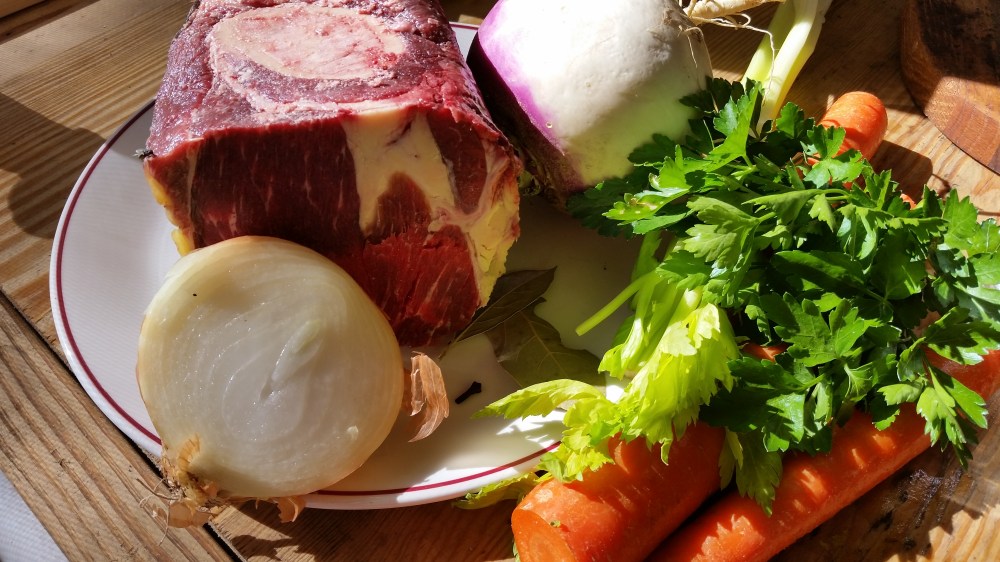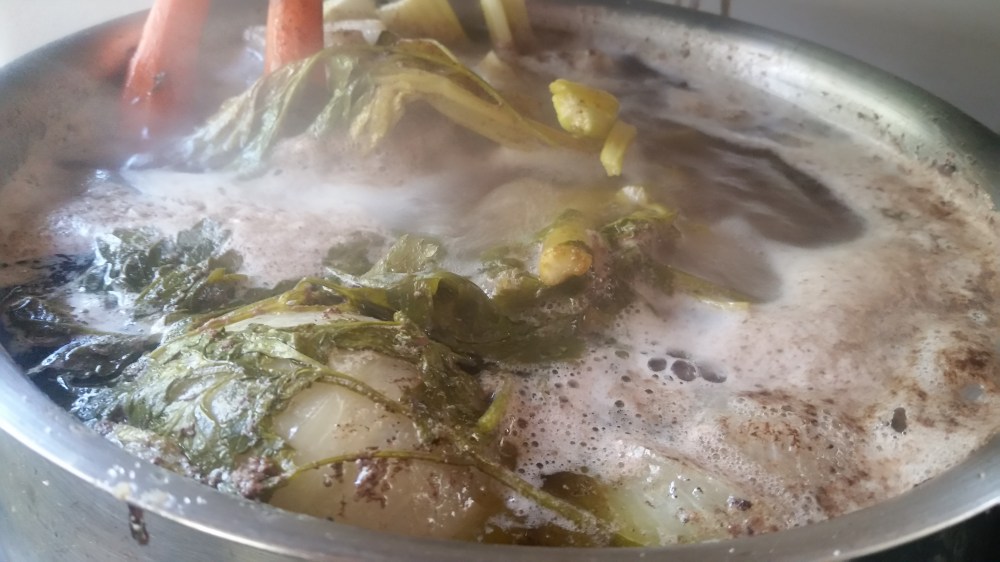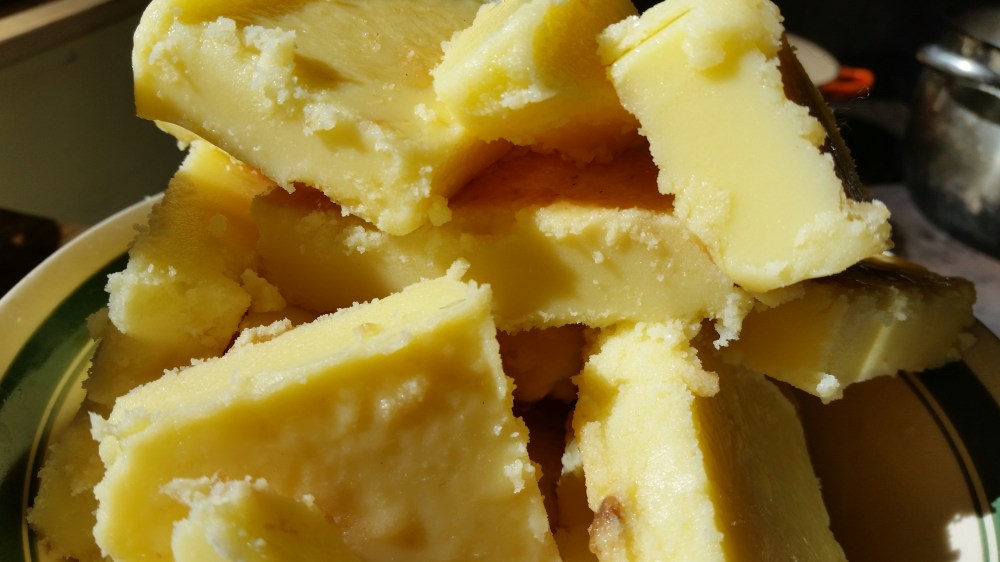


Broth is one of those amazing ingredients that makes everything taste good. With some broth on hand, you can make soups, sauces, gravies or cook beans, grains and vegetables in it. Everything you add it to will be rich and flavorful. Well-made broth not only tastes good, but also is a powerful healer and nourisher. It can protect you from sickness and infections and helps your body heal. The gelatin in well-made broth not only makes your skin supple and your hair shine, but also nourishes the cells that build bones and teeth. Here is a traditional French recipe that leaves you with boiled beef, vegetables, and quantities of delicious broth.
The basic idea of broth is easy – you put things into a pot and boil them. But…as I’ve discovered, it’s not actually quite that easy. You’ll certainly end up with broth by boiling things, but anyone who’s tried to make bone broth at home will realize that there are some finer points that make broth taste excellent:
- Use marrow bones and odd bits as well as meat. You can make broth with a roast of meat, a whole chicken, or even just vegetables, but the best broth is made with the odd bits – pig ears, trotters, beef knuckles, ox tails, giblets, and chicken necks and feet to name a few. Marrow bones add richness as well, but for really out-of-this-world broth, use some of those odd knuckly-things. The collagen they impart transforms the broth from something ho-hum into the essence of incredible flavor. People who have trouble breaking their processed food addictions just haven’t experienced broth of this calibre before. It makes you realize what all the guar gum and flavor chemicals are trying so hard to imitate in commercial soups and sauces.
- Roast or brown the meaty ingredients. Browning or roasting meat creates caramelization that adds a depth of flavor and umami to your broth. Left-over roasts of meat or whole chickens make excellent broth. If you are starting with raw bones, season them with salt and pepper and roast them in the oven at 350 F for a half hour or until they look browned and toasty. Even the odd bits you are adding should be toasted for maximum flavor.
- Add extra flavor items. raw or sautéed onions, mushrooms, vegetables, generous bouquets of fresh herbs, garlic, white or red white, L’eau de vie, lemon or orange, peppercorns, bay leaf, and dried herbs and spices. This is where the modern idea of everything being as consistent as possible when it comes to food gets thrown out of the window. No two pots of broth should taste the same! Personally, I get sick of things that taste exactly alike all the time, which is why pre-mixed spice mixes never seem to get used in my kitchen. Use fresh ingredients and good quality dried herbs and spices, and it will always taste good, even if it doesn’t taste exactly the same from batch to batch.
- Skim the foam. When a batch of broth first comes to a boil, foam will rise to the top. This happens when you are cooking beans as well. Skimming this foam away can removed off-flavors. The French cookbook I am translating cautions against skimming too often, so one good skim should do it, without removing the good flavors or the gelatin that will crust at the top.
- Keep the lid cracked or off. You don’t want your broth to get too hot. This can make the fats turn rancid and break down the gelatin. If you are worried about the liquid level, you can put the lid on, but prop it up by laying a wooden spoon along the top edge of the pot. This keeps the lid cracked and allows some steam to escape, but the broth won’t get too hot.
- Use good water. Making broth concentrates the water that you are using, so you want to use good-quality water. Chlorine from city tap water will evaporate, but the toxic fluoride will actually become concentrated which could be a concern if you drink a lot of concentrated broth. If your water is high in good minerals like calcium and magnesium, these will be concentrated as well as the broth cooks down.
- Long, slow cooking time. The flavors need time to mingle and be drawn out. In the winter, it is pleasant to have a fragrant pot of soup on the stove, but in the summer it can be awful to have something producing steam and heat inside. The best broth will cook for hours, if not several days. In cold weather, I’ll have a stock pot on the stove and let it simmer all day. At night, I put the lid on and let the broth heat for a minute (but not too much), turn off the heat and leave it until the morning. In the morning, I remove the lid and bring the broth back up to a boil. In the summer time, I heat up my broth to a boil both morning and evening, and I store it in the same way, with the lid on, during the day and night when it is not heating. I usually cook broth for 2-3 days, and will often strain and then further cook it down longer. Keep the heat low to medium for best flavor results.
- Skim off the fat layer on top. I am all for traditional amounts of fat in the diet, but sometimes you can get serious layers of fat when making broth that will make the broth taste “off” and are unpleasant to try to eat through. Even in my French cookbook, the advice is always to “de-fat” the broth. You can do this in several ways – either by skimming the top layer with a ladle or scooping up broth from where it is boiling (the fat layer gets pushed aside). My favorite way to de-fat stock is to let it cool and scrape the layer of fat off with a spoon. Some fats are stable enough to be collected and used as cooking fat. Beef tallow from the top of beef stock makes great fried potatoes!
- Reduce, reduce, reduce. Reducing, or boiling the broth down, concentrates the minerals, gelatin, and flavor. It also makes broth much easier to store when you can get a gallon of broth down to a quart or two. Reduce broth by straining the meat and vegetables out, and putting it into a fresh pot. This pot can be boiled at a higher temperature than before, but keep the lid off so as much steam as possible will escape. It should reduce fairly quickly, so keep an eye on it, unless it is a massive pot full of liquid. This is how you make the famous consommé stock. It is called consommé because it is “consumed” as it boils away.
- Use a proper ration of water to meat. Adding too much water will make a weak broth. Generally, I add water to cover, and then 1 inch more. This seems to make a good broth strength, without fear of it cooking down too quickly and burning.

Chunks of tallow from a batch of beef bone broth.
Conservation Of Broth:
This is what R. Blondeau, the chef who wrote La Cuisine says about saving broth (remember, this was before wide-spread refrigeration):“[T]he soup is not likely to keep more than two days in hot weather, and four days in cooler temperatures. Beyond this time, it becomes sour. Others have come up with different ways to get rid of this acidity; we will not go into them here, as we cannot be certain of their effectiveness. But you may try to prevent it: an excellent way is to bring the extra broth to a boil, morning and evening in summer, and once a day in winter. This will help it keep at least as long as the times mentioned above.”

This is what amazing broth looks like once it’s been cooked down and cooled in the fridge.
4 Comments Add yours